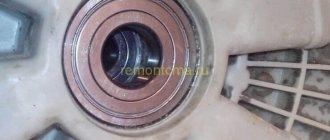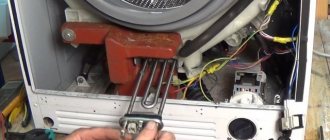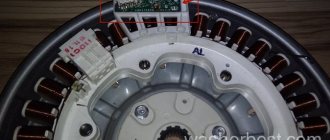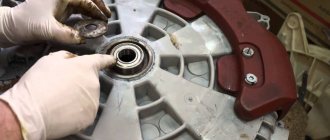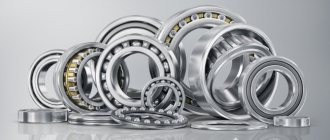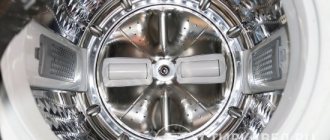How do you know what needs to be replaced?
To identify a malfunction of the heating element, you need to make sure that the water is not actually heated. To do this, 15 minutes after starting the wash, touch the door with your hand, and if it is cold, this indicates a malfunction of the heating element. This is the only visible sign by which the user can independently identify the lack of heating.
Many models of washing machines have a self-diagnosis system that displays an error code when a malfunction is detected. Error coding varies from manufacturer to manufacturer, so to decipher the code you will need to read the instructions for your washing machine model.
The causes of heating element failure may be the following:
- violation of the integrity of the wiring, as a result of which the heating element does not receive signals about the start of operation and the need for heating;
- burnout of the heating element, which requires immediate replacement;
- breakdown of the thermostat responsible for determining the water temperature;
- accumulation of a thick layer of scale and salt deposits, which significantly reduces the thermal conductivity of the metal. The heating element cannot give off the necessary heat and heat the water to the specified temperature. Then more electricity is used for heating, and as a result of overvoltage, the heating element burns out.
Expert opinion
It-Technology, Electrical power and electronics specialist
Ask questions to the “Specialist for modernization of energy generation systems”
How to replace the heater on a Zanussi washing machine, how to remove the heating element for repair Do not throw anything under your feet, all elements of the washing machine, electrical appliances and tools must be in order and in their places. Ask, I'm in touch!
Causes of malfunction
A heating element (a commonly accepted abbreviation for “tubular electric heater”) is a metal tube filled with an electrical insulator with good thermal conductivity. In the middle there is a conductive (fechrome, but more often nichrome) thread, which heats up when connected to the network. The heating element in an automatic washing machine is used to heat water in accordance with the programmed program or the temperature set by the user.
The heating element is one of the most susceptible parts in a washing machine.
On the one hand, this is due to the frequency of operation of the spiral, which either heats up or cools down. But the most common reason why the heating element has stopped working is scale deposits caused by high water hardness. A thick layer of scale causes a disruption in heat transfer, the coil overheats and burns out. Replacing the heating element in a washing machine does not require much effort and can be done at home yourself. See also -
How to check the water level sensor in a washing machine
Replacing the heating element in a washing machine with your own hands
- Insert the new heating element into the niche and check that it fits tightly into place and does not wobble. It is necessary to ensure tight fixation without distortions or gaps;
- holding the element, tighten the nut until it stops, but without strong force so as not to squeeze out the element;
- attach the wires and terminals to the shank in their original places;
- turn on the test washing program with heating up to 60 degrees. If the water is heating up (this can be checked by placing your hand on the door 10-15 minutes after the start of washing), then secure the back panel and tighten the body.
Where is the heating element located?
Users often encounter difficulties in locating the heating element. In different models, access to the heating element is provided through the rear or front panel. To find out the location of the part in your device, read the instructions or inspect the washing machine.
Initially, inspect the back panel, and if the removable part is large enough, most likely the heating element is located there. If only a small cover is removed from the back, then try looking for the heating element under the front cover.
Replacing the heating element
It is quite easy to determine the heating element by two characteristic connectors to which the wires are connected. However, if you have an ohmmeter at hand, before removing it, you should check the heating element - perhaps the malfunction is not caused by its failure. The resistance of the heating element in operating condition does not exceed 200 Ohms, otherwise it requires replacement.
Important:
Before starting work, we recommend photographing (sketching) the location of the wires and the order in which they are connected.
We install the protective housing covers in place - the operation is completed. We carry out control - we turn on the function in which the water heats up over 50 degrees. If the hatch cover heats up, then everything is done correctly.
Expert opinion
It-Technology, Electrical power and electronics specialist
Ask questions to the “Specialist for modernization of energy generation systems”
A heating element for a washing machine: how to check and replace it yourself. After all, you will have to remove the top cover, dismantle the tray for detergent powder, partially disassemble the laundry hatch, and only then remove the front panel itself. Ask, I'm in touch!
Preparatory stage
Buying a new heating element for a washing machine is not difficult; it is only important that it is intended specifically for this model. Despite the fact that they differ little in design, there may be some differences in size, spiral shape, etc. In addition, for repairs you will need a set of screwdrivers, tubular and wrenches, as well as sealant. It’s good if you have a tester or ohmmeter - it will be useful to make sure that the heating element is malfunctioning or working properly.
Important:
Before starting work, be sure to turn off the power to the washing machine, disconnect it from the water supply, and also drain the water using the drain filter.
How to replace the heating element located at the front?
- To remove the front panel of the machine, you need to remove the two screws on it, pull the part back and put it aside.
- Then the detergent compartment is removed. To do this, unscrew the screws (there are two of them) and by pressing the latch on the back side, the part is pulled out.
- You will have to remove the seal on the loading tank. To do this, you need to remove the metal hoop by stretching the spring.
- Now is the time to tackle the front cover. It is attached with screws and possibly additionally held on by clips, so pull it forward and down.
- Time to work on the wires on the door lock. You can disconnect them without difficulty.
- Let's move on to the heating element located at the bottom of the tank. To begin, remove the terminals, temperature sensor connectors and ground wire located at the end of the part. This is done to remove the temperature sensor.
- On the heating element, you need to unscrew the fastening nut and press the bolt inward.
- Before pulling the part out, rock it up and down a little.
- Cleaning work. It is necessary to remove all debris, remaining powder and scale from the tank.
- Installing a new heating element occurs in the reverse order: connect the temperature sensor and insert it into place, connecting all the wires and tightening the nuts.
- We are assembling the car.
In washing machines Indesit, Whirlpool and some other models, the heating element is installed at the back, which allows you to replace the part yourself without much effort.
Tip: to avoid further leakage, pour a ladle of water into the tank above the heating element level. If you see a leak from under the seal, it is better to tighten the fastening nut a little.
Important! The heating element inside the drum is held by a metal bracket and if the end of the heating element does not fall into the bracket, then during operation the drum will touch it and disable the machine.
What kind of lighting do you prefer?
Built-in Chandelier
The work is done, we figured out how to replace the heating element on the washing machine and it is ready for use.
Expert opinion
It-Technology, Electrical power and electronics specialist
Ask questions to the “Specialist for modernization of energy generation systems”
How to check and remove the heating element for a washing machine: video To protect the heating element for the Indesit, Samsung, Bosch or LG washing machine from scale formation during operation, it must be cleaned regularly. Ask, I'm in touch!
Tips and tricks
When performing basic work on dismantling an old heating element, it is recommended to follow the following rules:
- Several electrical wires are connected to the heating element, which can be mixed up when subsequently installing a new element. To prevent this from happening, it is recommended to take a photograph of the connected wires before proceeding with dismantling.
- The middle nut of the heating element does not have to be completely unscrewed. To remove the heating element, simply unscrew it a few turns and push the bolt inside the tank. When performing such actions, the bracket holding the heating element will be weakened and the part can be easily removed.
- Be careful when prying off the rubber gasket using a sharp slotted screwdriver. Careless actions can lead to a puncture of this part, which will render it unusable.
Following these simple rules will allow you to perform the operation of removing the heating element without any negative consequences for the performance of the household appliance.
Replacement heating element Ariston.
First, remove the drive belt, as it will get in the way, and remove the ground and temperature sensor connector.
Now you need to loosen the tension nut, but under no circumstances unscrew it completely, just loosen it. If you unscrew it all the way, you will have difficulty removing the ten.
Now we take a pair of flat-head screwdrivers and, with deft movements, we pry the tench by the metal body, then we swing it and pull it towards ourselves, taking it out.
Here is a faulty Ariston heating element and a temperature sensor. The photo below shows that there is a layer of scale on the surface of the heater. Scale prevents normal heat exchange between the heater and water, resulting in overheating of the element. Scale is the main cause of heating element failure.
Before installing a new heater, we clean the seat in the tank with a rag from dirt and pieces of scale that fell off the heater when it was removed, and then install the new element.
Tighten the heater tightening (fixing) nut well so that when heating it does not get squeezed out of the tank, but there have been cases. Then we assemble everything in reverse order. We check the machine on the washing mode, if everything is in order, we are happy and use it.
Expert opinion
It-Technology, Electrical power and electronics specialist
Ask questions to the “Specialist for modernization of energy generation systems”
Heating element for washing machines: diagnostics, replacement, device 7 video Despite this, it will not work to install a long water heater instead of a short one, just like a curved heater instead of a straight one. Ask, I'm in touch!
Indesit
In order to remove the heating element from an Indesit brand automatic washing device, you must perform the following steps:
- Remove the back cover.
- Disconnect the wires.
- Using a socket wrench, unscrew the nut located in the middle of the base.
- Gently hit the bolt with any hard object so that this part is pushed inside the tank.
- Use a thin screwdriver to pry up the base of the heater, pull it towards you and remove it from the washing machine tank.
At this point, the operation to remove the heating element can be considered complete.





